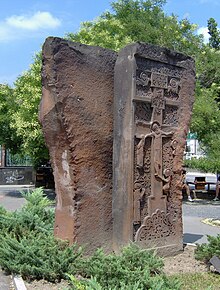Armenians in Serbia
This article needs additional citations for verification. (March 2019) |
 | |
| Total population | |
|---|---|
| 222 Serbian citizens (2011)[1] | |
| Regions with significant populations | |
| Belgrade, Novi Sad | |
| Languages | |
| Armenian and Serbian | |
| Religion | |
| Armenian Apostolic Church | |
| Related ethnic groups | |
| Armenian diaspora |
Armenians in Serbia (Armenian: Հայերը Սերբիայում, romanized: Hayery Serbiayum; Serbian: Јермени у Србији, romanized: Jermeni u Srbiji) refers to ethnic Armenians living in Serbia.
History
[edit]Armenians were recorded in Serbia in 1218 when Saint Sava invited constructors to build a Serbian Orthodox monastery after he had been to Armenia and seen the Armenian architecture there. The Armenians were to build Vitovnica Monastery, which has preserved a bilingual sacral text in Serbian and Armenian dating to the building.[2]
Armenians were a small part of the Ottoman Turkish army when they invaded Serbia prior to the Battle of Kosovo 1389. However upon hearing that they would attack a Christian people, they fled the Ottomans to the other side to fight alongside the Serbs. After the battle, the surviving Armenians settled in the hills of Sokobanja where they built Jermenčić Monastery.[2]
Evliya Celebi registers an Armenian "district" of Užice in the 17th century.[3]
Remains of an Armenian graveyard lie in Kalemegdan fortress, which was last used in the 17th century after the Ottomans destroyed it. Only a few tombs are left in good condition. In 1810, the Turks destroyed the Celije Monastery, and the Serbs rebuilt it in 1811 with the help of wealthy Armenians. One of the benefactors had his idea of an Armenian style dome included in the work, so the monastery today can be considered an outcome of Byzantine/Serbian-Armenian architecture.
In 1880s, merchants from the Gamakh region in Armenia settled in Valjevo (Tehlirians). Among the Tehlirians was Soghomon Tehlirian's father.[4] During the Second World War, many Armenians moved to North America and France.
In the past, there used to be an Armenian Catholic church in Novi Sad (built in 1746, razed in 1963).
Some 500 female Serbian descendants of Armenians married Serbs in the 1990s.[2]
Recent history
[edit]
Armenia and Serbia established diplomatic relations in 1992. Armenia is represented in Serbia through its embassy in Athens, Greece. Serbia is also represented in Armenia through its embassy in Athens. The "Armenka" association of ethnic Armenians in Serbia which holds community affairs is led by Gohar Harutyunyan-Sekulic.
On 28 July 2009, Boris Tadic arrived in Armenia, becoming the first Serbian head of state to visit Armenia. The presidents wished to improve the spiritual, cultural and economic relations of the two countries stressing that the centuries-long friendship between the peoples was a good basis for boosting their bilateral relations. Armenia has not recognized the unilateral declaration of independence of Kosovo.[5]
Serbian president, Tomislav Nikolić, was one of the heads of state to visit Yerevan on the occasion of the 100th anniversary of the Armenian genocide.[6]
Armenian president, Armen Sarkissian, visited Serbia in October 2019 to discuss ways in which the two countries can increase ties.[7]
See also
[edit]References
[edit]- ^ "Попис становништва, домаћинстава и станова 2011. у Републици Србији: Становништво према националној припадности - "Остали" етничке заједнице са мање од 2000 припадника и двојако изјашњени" (PDF). Webrzs.stat.gov.rs. Archived from the original (PDF) on 17 April 2016. Retrieved 23 March 2019.
- ^ a b c "Parastos kod Krsta u kamenu". Arhiva.glas-javnosti.rs. Retrieved 23 March 2019.
- ^ Danijela Gavrilović (2003). "ELEMENTS OF ETHNIC IDENTIFICATION OF THE SERBS" (PDF). Philosophy, Sociology, and Psychology. 2, 10: 717–730. Retrieved 23 March 2019.
- ^ Derogy, Jacques (31 December 2011). Resistance and Revenge: The Armenian Assassination of Turkish Leaders Responsible for the 1915 Massacres and Deportations. Transaction Publishers. p. 65. ISBN 9781412833165. Retrieved 23 March 2019 – via Google Books.
- ^ "B92 - News - Politics - Tadić ends Armenia visit". Archived from the original on 2009-07-30. Retrieved 2010-02-02.
- ^ Danielyan, Emil (24 April 2015). "Putin, Hollande Join Armenian Genocide Remembrance in Yerevan". «Ազատ Եվրոպա/Ազատություն» Ռադիոկայան.
- ^ "'We perceive Serbs as brothers in faith and destiny' – Armenian President's interview to Politika".
External links
[edit]- "BABKEN SIMONJAN Jermeni i Srbi su braća po stradanju". Pecat.co.rs. 26 August 2010. Retrieved 23 March 2019.
- ""Армяне в Сербии в XIII-XX веках" - Бабкен СИМОНЯН". Aniv.ru. Retrieved 23 March 2019.

